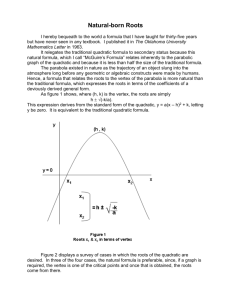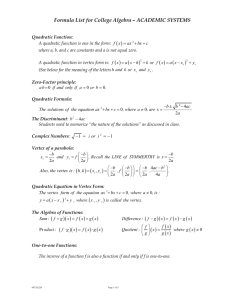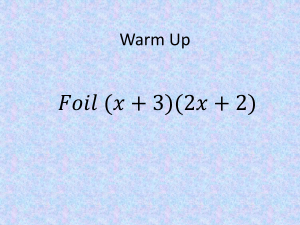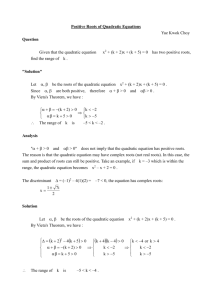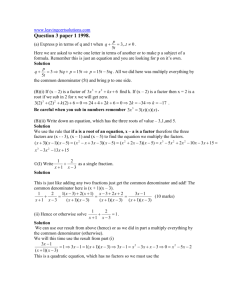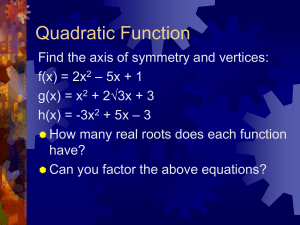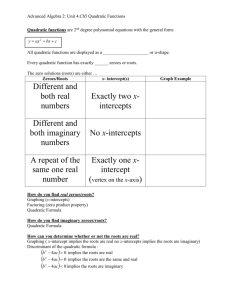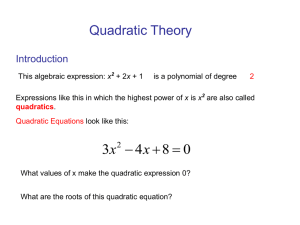Quadratic Formula - PHA Math Central
advertisement
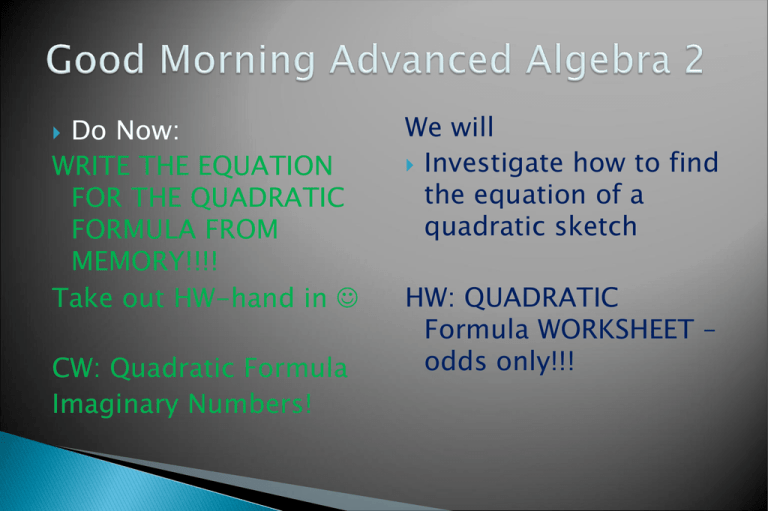
Do Now: WRITE THE EQUATION FOR THE QUADRATIC FORMULA FROM MEMORY!!!! Take out HW-hand in CW: Quadratic Formula Imaginary Numbers! We will Investigate how to find the equation of a quadratic sketch HW: QUADRATIC Formula WORKSHEET – odds only!!! Intro: We already know the standard form of a quadratic equation is: y = ax2 + bx + c The coefficients are: a , b, c The variables are: y, x The ROOTS (or solutions) of a polynomial are its x-intercepts The x-intercepts occur where y = 0. Roots Example: Find the roots: y = x2 + x - 6 Solution: Factoring: y = (x + 3)(x - 2) 0 = (x + 3)(x - 2) The roots are: x = -3; x = 2 Roots After centuries of work, mathematicians realized that as long as you know the coefficients, you can find the roots of the quadratic. Even if it doesn’t factor! y ax 2 bx c, a 0 b b 2 4ac x 2a Watch this: http://www.youtube.com/watch?v=MUw9C1p5Y0g&f eature=related (another time…) http://vihart.com/doodling/ Extra Credit if you create a video/song/anything creative!! You have 2 weeks! Solve: y = 5x 8x 3 a 5, b 8, c 3 2 8 64 60 x 10 2 b b 4ac 8 4 x x 2a 10 2 (8) (8) 4(5)(3) 8 2 x x 2(5) 10 8 2 x 10 8 2 10 x 1 10 10 82 6 3 x 10 10 5 Roots 2 y 5 35 8 35 3 y 5 9 25 24 5 3 45 24 3 y 2 25 5 y 5(1) 8(1) 3 9 24 15 y y 583 5 5 5 y0 y0 Plug in your answers for x. If you’re right, you’ll get y = 0. 2 Solve : y 2x 7x 4 DO NOW ** WRITE THE EQUATION FOR THE QUADRATIC FORMULA FROM MEMORY then solve the quadratic above!!!! Class Work: AS PROMISED…. Imaginary numbers!! WE will: Solve Quadratics using quadratic formula!! Check out the world of IMAGINARY NUMBERS!!! HW: QUADRATIC Formula WORKSHEET – 1-10!!! 7 49 32 Solve : y 2x 7x 4 x 4 a 2, b 7, c 4 7 81 x 2 b b 4ac 4 x 7 9 2 1 2a x x 4 4 2 2 (7) (7) 4(2)(4) 16 x x 4 2(2) 4 2 Remember: All the terms must be on one side BEFORE you use the quadratic formula. •Example: Solve 3m2 - 8 = 10m •Solution: 3m2 - 10m - 8 = 0 •a = 3, b = -10, c = -8 Free Fallin’ The acceleration of gravity (g) for objects in free fall at the earth's surface is 9.8 m/s2. Galileo found that all things fall at the same rate. Free Fall The rate of falling increases by 9.8 m/s every second. Height = ½ gt2 For example: ½ (9.8 )12 = 4.9 m ½(9.8)22 = 19.6 m ½ (9.8)32 = 44.1 m ½ (9.8)42 = 78.4 m Free Fall A ball thrown horizontally will fall at the same rate as a ball dropped directly. Free Fall A ball thrown into the air will slow down, stop, and then begin to fall with the acceleration due to gravity. When it passes the thrower, it will be traveling at the same rate at which it was thrown. Free Fall An object thrown upward at an angle to the ground follows a curved path called a parabola. Air Resistance • In air… – A stone falls faster than a feather • Air resistance affects stone less • In a vacuum – A stone and a feather will fall at the same speed. Air Resistance • Free Fall – A person in free fall reaches a terminal velocity of around 54 m/s – With a parachute, terminal velocity is only 6.3 m/s • Allows a safe landing The initial velocity is the coefficient for the middle term, and the initial height is the constant term. The coefficient on the leading term comes from the force of gravity. This coefficient is negative, since gravity pulls downward, and the value will either be "4.9" (if your units are "meters") or "16" (if your units are "feet"). In general, the format is: s(t) = –gt2 + v0t + h0 ...where "g" here is the "4.9" or the "16" derived from the value of the force of gravity (technically, it's half of the force of gravity, but you probably don't need to know that right now), "v0" ("veenaught", or "vee-sub-zero") is the initial velocity, and "h0" ("aitch-naught", or "aitch-sub-zero") is the initial height. An object is launched at 19.6 meters per second (m/s) from a 58.8-meter tall platform. The equation for the object's height s at time t seconds after launch is s (t) = –4.9t2 + 19.6t + 58.8, where s is in meters. When does the object strike the ground? What do we know vs. What do we need to know? (3 min) I'll set s equal to zero, and solve: 0 = –4.9t2 + 19.6t + 58.8 0 = t2 – 4t – 12 0 = (t – 6)(t + 2) Then t = 6 or t = –2. The second solution is from two seconds before launch, which doesn't make sense in this context. (It makes sense on the graph, because the line crosses the x-axis at –2, but negative time won't work in this word problem.) So "t = –2" is an extraneous solution, and I'll ignore it. The object strikes the ground six seconds after launch. An object in launched directly upward at 64 feet per second (ft/s) from a platform 80 feet high. What will be the object's maximum height? When will it attain this height? Think Pair Share (3 min) What do I know? What do I need to find out?? The initial height is 80 feet above ground and the initial speed is 64 ft/s. Since my units are "feet", then the number for gravity will be 16, and my equation is: s(t) = –16t2 + 64t + 80 Yes? They want me to find the maximum height. For a negative quadratic like this, the maximum will be at the vertex of the upside-down parabola. So they really want me to find the vertex. From our past experience with graphing, I know how to find the vertex; in this case, the vertex is at (2, 144): x = –b/2a = –(64)/2(–16) = –64/–32 = 2 Y = s(2) = –16(2)2 + 64(2) + 80 = –16(4) + 128 + 80 = 208 – 64 = 144 But what does this vertex tell me? According to my equation, I'm plugging in time values and extracting height values, so the input "2" must be the time and the output "144" must be the height. It takes two seconds to reach the maximum height of 144 feet. 2 4 84 x 6 2 88 x 6 2 2 4 • 22 b b 4ac x x 6 2a 2 (2) (2) 4(3)(7) x 2 2 22 x 6 1 22 2(3) x 3 Solve: 3x2 = 7 - 2x Solution: 3x2 + 2x - 7 = 0 a = 3, b = 2, c = -7
